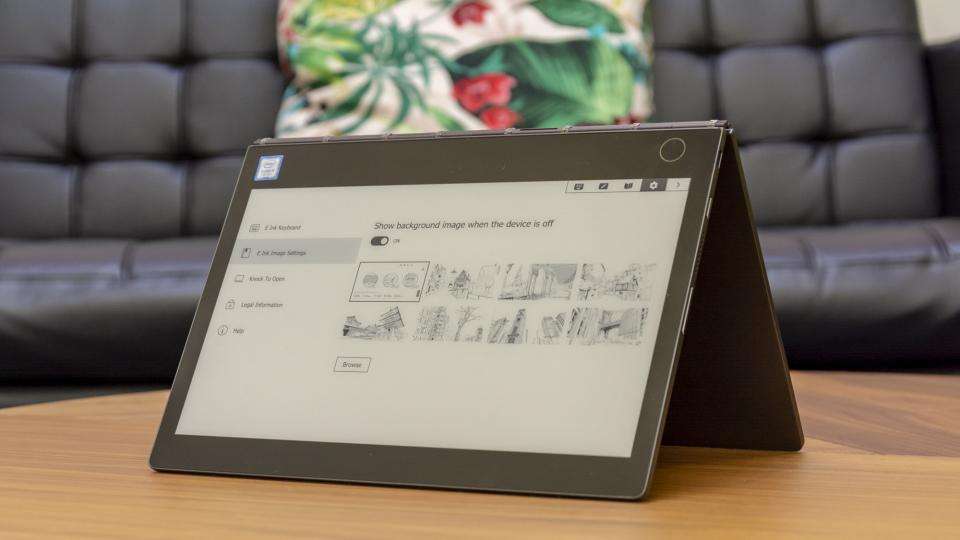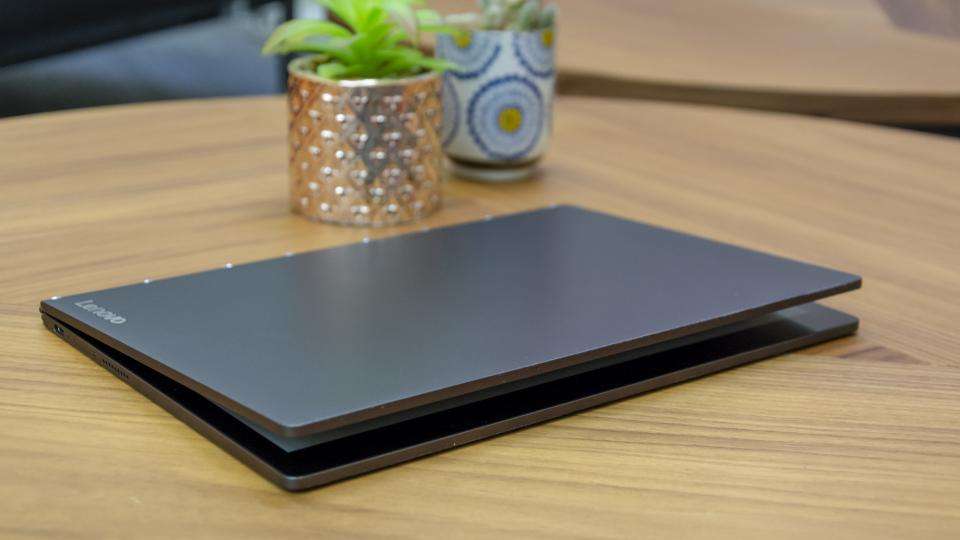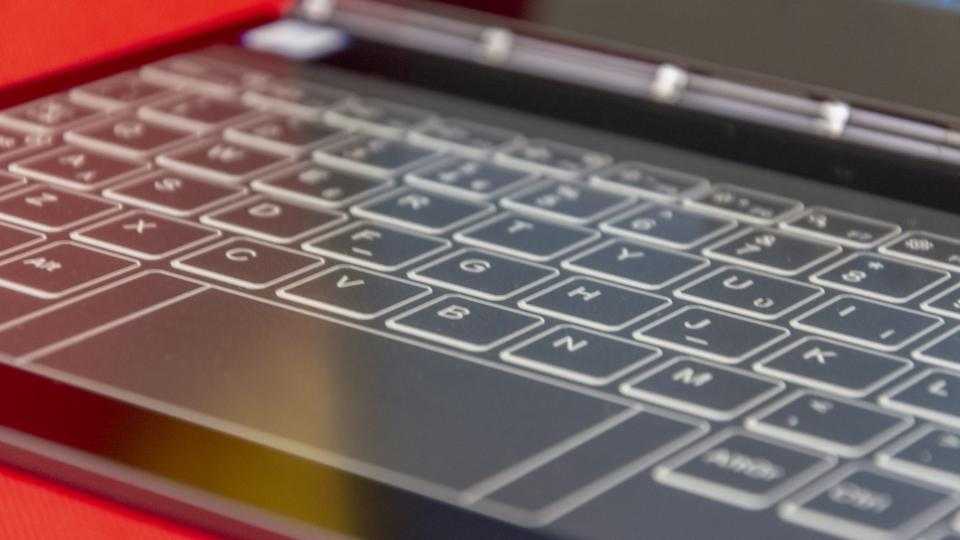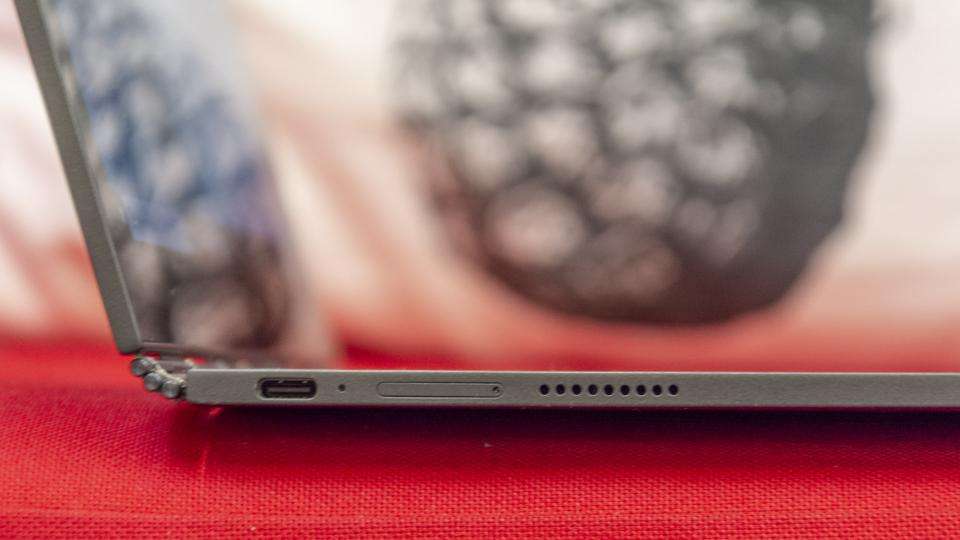For a while, it looked as though the Lenovo Yoga Book wasn’t coming back. The ultra-thin 2-in-1 was out of stock for months at a time and there was no sign of a replacement model. But the line has been unexpectedly revived – and revamped – with the release of the unique Yoga Book C930.
We gave the last Lenovo Yoga Book top marks for versatility and innovation but weren’t so keen on its sluggish performance and virtual HALO keyboard. The Yoga Book C930 is a significant step forward, with a higher display resolution and E Ink secondary display that switches between keyboard, drawing and ebook modes. The price has doubled since last time, however, and I’ve spent a week trying to figure out why.
READ NEXT: Best 2-in-1 laptops you can buy
Lenovo Yoga Book C930 review: What you need to know
Like all Lenovo Yoga devices, the Yoga Book C930 is a 2-in1 touchscreen laptop with a 360-degree hinge. It’s more compact than any other Yoga though, weighing a dainty 0.75kg and measuring only 9.9mm thick when closed due to the absence of a physical keyboard.
Instead, the Yoga Book C930 has a secondary E Ink Full HD 10.8in touch display that works not only as a virtual keyboard and drawing surface but as an ebook reader as well. I suppose you could call it a 3-in-1 – perhaps Lenovo’s marketing team missed a trick there?

The primary touch display, by the way, is the same size but uses a higher resolution, full-colour backlit 2,560 x 1,600 IPS panel. My review unit of the Yoga Book C930 runs on a dual-core 1.2GHz Intel Core i5-7Y54, helped along by 4GB RAM. There’s a 256GB SSD inside, although that can be topped up with a microSD, up to a total of 512GB. Previously, the Yoga Book was sold with the option of either an Android or Windows operating system but Lenovo has killed Android off for the C930, which runs on Windows 10 Home exclusively.
Lenovo Yoga Book C930 review: Price and competition
As mentioned earlier, the Yoga Book has doubled in price since the last version. It’s normal to see steady price bumps with new device generations (see all Apple products) but a 100% increase is quite the hike. The base spec Android Yoga Book from 2016 launched at £450, while the cheapest Windows model was £100 more at £550. Now, the Yoga Book C930 starts at £1,100. As for the model I’ve been sent to review, the price leaps once again to £1,300. That doesn’t even include the optional Precision Pen stylus, which tacks on an extra £90.
There’s nothing quite like the Yoga Book C930 with its dual 10.8in displays, and in that sense, it doesn’t have much direct competition. I will point out that for £1,330 (£30 more than this Yoga Book C930) you could buy a Dell XPS 13 2-in-1 with an Intel Core i7 CPU. The mid-tier Microsoft Surface Pro 6 is £1,375 with the Signature Type Cover and Surface Pen included, which is still cheaper than the Yoga Book C930 with its Precision Pen.
For £1,300 you could also buy the Lenovo Yoga C930 (similar name, different device), an exceptional 2-in-1 that was unveiled alongside the Yoga Book C930 at IFA 2018. And I shouldn’t leave out the 12.9in Apple iPad Pro , available from £1,287 with the stylus and keyboard included. Of course, it runs on iOS so you don’t get the true laptop experience but it’s the fastest tablet on the market and it packs a lot more power than the Yoga Book C930.
Lenovo Yoga Book C930 review: Design
In the same way that the Yoga Book C930 doesn’t really have any competitors, there’s nothing that looks like it either – apart from the old Yoga Book, that is. Closed, it’s just two slabs of iron-grey aluminium held together by Lenovo’s funky “watchband” hinge. It’s a tiny thing and slides easily into an A4 envelope with ample room to spare on all sides.

To open it, you rap twice on the lid with a knuckle. This causes the lid to pop open a crack, and from there the screen can easily be lifted into position. Besides looking cool, this knock-to-open function is cleverly designed, using two opposing magnets which are forced apart by successive taps. To open the laptop in less dramatic fashion you can simply hold down the volume button on the right-hand edge.
Once open, you’re presented with two screens. Above is the 10.8 IPS display, boxed-in on all sides by bezels that are conspicuously large for a laptop originally released in 2018. The webcam also lives above the screen but there’s no camera privacy shutter as there is on the Lenovo Yoga C930 . There’s also no secondary IR camera for face unlock, although the first generation Yoga Book did have one.

Where the keyboard would normally be is a smooth 10.8in panel. This is the “Flexible E Ink Mobius” touch display, which has replaced the HALO keyboard and notepad from the last Yoga Book. You may be familiar with E Ink technology if you’ve ever used an ebook reader but this is a tweaked version of the technology which incorporates a keyboard and drawing functions. I’ll go into more depth on these modes later. Above the keyboard is a semi-reliable fingerprint reader that smudges a bit too easily and thus doesn’t always work.
Those used to traditional laptops will have a tough time adjusting to the Yoga Book C930’s lack of ports. In addition to a dual microSD and SIM slot on the left edge, there are two USB Type-C (Gen 1) slots – one on either side – but one of those will usually be occupied by the power supply. That leaves you with a single connector to plug in a peripheral device. Lenovo hasn’t even provided a 3.5mm audio jack for headphones, meaning you’ll need to use an adapter (not provided) or Bluetooth headphones to listen to audio privately.

And headphones are recommended, whether you’re in public or not, because the audio output of the Yoga C930’s dual side-mounted speakers could be better. Although not abysmal, it’s not as loud or crisp a sound as you’d expect from a laptop costing over £1,000.
It’s disappointing the Precision Pen stylus (£90) isn’t bundled-in either since you’re already spending so much. This is a battery-powered metallic stylus, slightly longer and thicker than a Bic Biro pen, has two buttons, and sticks to the laptop’s back magnetically when not in use. The Precision Pen isn’t essential for standard touchscreen activities but you’ll need it to take full advantage of the E Ink input display.
Lenovo Yoga Book C930 review: E Ink keyboard and E Ink Note
The E Ink display is the Yoga Book C930’s star feature and the laptop’s success relies on this working well. I can see the appeal because it truly is versatile but I’m not fully sold on the practicalities. I’ll start with the virtual keyboard. There are two layouts available, modern or classic, and you can also choose between black or white styles. Whatever you choose, there’s no getting around the slow key response, which lags behind even a modest typing speed.
And since these aren’t real keys but rather sensors on a panel, they have no tactile feedback, making it immensely difficult to touch type on. When typing, I found myself looking down almost constantly to make sure my hands stayed in the right place. You can set the keyboard to vibrate when you hit a key but even with this set to maximum strength there’s not enough sensation to make you feel as if you’re actually typing. The virtual touchpad is also abnormally small and frustrating to use. In the “modern” keyboard layout it’s just a small button that expands when you tap it, swallowing the space bar and disappearing when any other key is pressed.
Annoyingly, the Precision Pen stylus cannot interact with the E Ink keyboard. When you’re already holding the stylus it feels like this would be more intuitive than bringing up the main display’s on-screen keyboard, which obscures the entire bottom half of the screen. The Pen’s main function is for drawing on the E Ink Note surface, of course, and it works perfectly well here. This “Note” mode is not without its problems, however.
To begin with, the Yoga Book C930 is slow to swap between keyboard and note functions and sometimes it fails to load entirely. Many times I’ve tapped the Note button on the E Ink panel and been presented with a blank display for five seconds, only to be brought back to the keyboard. When I did make it to Note mode, I found it was accurate and responsive, both for drawing and writing.
There’s a button that allows you to draw with your fingers and Note mode also has a screen-grab function for annotation purposes. Simply press one button and the main display is mirrored onto the secondary display. Of course, the E Ink Note mode is entirely black and white, which may not be an issue when annotating a word document or PDF but for designers and artists, the lack of colour is hardly ideal.
Lenovo Yoga Book C930 review: Ebook reading mode
And now onto the third and final function of the E Ink display: reading ebooks. Lenovo doesn’t list all the formats you can read in this mode but it is definitely compatible with EPUB, MOBI, TXT and PDF.
Reading ebooks and PDFs on the display is awkward, to say the least. Because said display is attached to a laptop, it’s unwieldy to use on the go and cannot be held comfortably or safely in just one hand. It’s much easier to prop up the laptop in “tent” mode and read hands-free. Page turning works by tapping the corners but this often elicits no response. There’s also the option to keep the laptop flat and read in landscape mode, and you can turn this into a two-page spread with two smaller pages visible side by side.
At 10.8in, the Yoga Book’s E Ink screen is much bigger than the next largest ebook reader we’ve reviewed, the 8in Kobo Forma although you can buy a 13.3in ebook reader – the Onyx BookMax 2 – so the Yoga Book C930’s E Ink display isn’t quite the world’s largest. The ebook function is a nice touch but the lack of Kindle file format compatibility will make it pointless for many. Lenovo hasn’t said whether or not the Yoga C930 will support Kindle ebooks down the line – it would certainly be a nice addition in future models.
Lenovo Yoga Book C930 review: Display
The Yoga Book C930’s primary display is a more regular affair. It’s a 10.8in, 2,560 x 1,600 touch-enabled IPS panel. It’s closer in size to a tablet display, which isn’t ideal for work purposes, but the quality of the display itself is good.
It has sRGB colour gamut coverage of 97.2% although there is a tendency to oversaturate across much of this range – green, reds and yellows are where it’s worst. The screen is a touch on the reflective side and this effect is worsened by the weak maximum brightness of 308cd/m2. Put simply, it’s hard to view the display outdoors or under bright lights. The 1,174:1 contrast ratio is fine, though. As long as you can deal with the diminutive proportions, the viewing experience on the Yoga Book C930 is enjoyable but you have to bear in mind the aforementioned inaccuracies if you’re intending to use it for professional image and video work.
Lenovo Yoga Book C930 review: Performance and battery life
Lenovo has really scrimped when it comes to internal specifications, and it shows in the benchmark results. The Yoga Book C930 is equipped with a previous-generation Intel Core i5-7Y54, a low-power dual-core chipset that was first released in mid-2016. This is backed by only 4GB RAM. Unsurprisingly, these specifications make it the slowest performing laptop we’ve reviewed in ages.
In our in-house 4K Media multitasking benchmarks, the Yoga Book C930 achieved a paltry overall score of 25. Laptops typically take a few hours to get through this test, but this device took the best part of a weekend. In the same benchmark, the Microsoft Surface Pro 6 scored 69 overall and that’s actually on the low-end for laptops in this price bracket. The Yoga Book C930 can still handle a bit of multi-tab browsing or really low-end games but you can forget about demanding video editing and gaming.
The GeekBench results shown above further demonstrate the Yoga Book C930’s sub-par internals. The Yoga Book C930’s i5-Y754 reached a multi-core speed of 6,500, while the 12.9in iPad Pro and Microsoft Surface Pro 6 scored double that.
It’s a similar story in the graphics benchmarks. The Yoga Book C930’s CPU has an integrated Intel HD 615 Graphics chip that’s really not up to much, reaching an average on-screen frame rate of 20fps in the GFXBench Manhattan test and 40fps off-screen (at 1080p). Compare that with the 59fps (on-screen) and 209fps (off-screen) scored by the 12.9in iPad Pro and you can see how ill-equipped the Yoga Book C930 is for gaming.
The Surface Pro 6 didn’t fare all that well in the Manhattan test either but was better in the 720p DiRT Showdown benchmark, cranking out an average 35fps to the C930’s 16fps. That’s the difference between playable and unplayable, although I wouldn’t recommend either device for gaming.
The Yoga Book C930 is only equipped with a 256GB SSD but performance in this area is reasonable, with sequential file read speeds of 1,200MB/s and write speeds of 531MB/sec. In fact, it’s much speedier in the storage department than the Microsoft Surface 6 Pro and, as the chart above shows, it has more impressive SSD sequential write speeds than the new HP Spectre x360 13 and Yoga C930.
With the battery life results, it’s back to the bad news, unfortunately. In our standardised battery rundown benchmark, the Yoga Book C930 lasted a mere 6hrs 16mins of continuous video playback. It’s hardly the all-day “marathon” machine that Lenovo promised, as the machine powered down two hours earlier than the Surface Pro 6 in the same test. The 12.9in iPad Pro, on the other hand, made it through to 10hrs 20mins. If you’re planning to take the Yoga Book C930 out of the house make sure your charger comes along as well.
Lenovo Yoga Book C930 review: Verdict
Despite its many shortcomings, there’s no denying the Lenovo Yoga Book C930 is unique. It’s just about the most portable Windows laptop you can buy and the E Ink Mobius display makes it incredibly versatile. The lack of a physical keyboard is hard to reconcile, however, and if Lenovo plans to make more Yoga Books like this it needs to improve E Ink typing; writing anything longer than an email on the Yoga Book C930 is painful.
The horribly slow speeds are another major downfall of the Yoga Book C930 with the aged dual-core Y-Series chip giving it the performance of an Android tablet. No matter how useful the E Ink display may be for designers and artists – and that’s debatable – it is not sufficient justification for charging £1,300 for this level of performance and inconvenience.
|
Lenovo Yoga Book C930 specifications |
|
Processor |
Intel Core i5-7Y54, dual-core,1.2GHz-3.2GHz (Q3 2016) |
|
RAM |
4GB |
|
Additional memory slots |
0 |
|
Max. memory |
4GB |
|
Screen size |
10.8in |
|
Screen resolution |
2,560 x 1,600 |
|
Pixel density |
279.5ppi |
|
Screen type |
LCD IPS |
|
Touchscreen |
Yes |
|
E Ink screen size |
10.8in |
|
E Ink screen resolution |
1,920 x 1,080 |
|
E Ink screen pixel density |
203.97ppi |
|
E Ink screen type |
Flexible E Ink Mobius |
|
E Ink touchscreen |
Yes, and stylus support |
|
Pointing devices |
Touchscreen, E Ink displayand Precision Pen (not included) |
|
Graphics adapter |
Intel HD Graphics 615 |
|
Graphics outputs |
USB-Type C x2 |
|
Graphics memory |
1GB (1024MB) |
|
Storage |
256GB (microSD up to 512GB) |
|
Optical drive |
No |
|
Memory card slot |
microSD |
|
USB ports |
USB-Type C x2 |
|
Other ports |
None |
|
Web Cam |
1080p, 16:9, 30fps |
|
Speakers |
Stereo speakers x 2 |
|
3.5mm headphone jack |
No |
|
Wi-Fi |
802.11 a/b/g/n/ac dual channel |
|
Bluetooth |
Bluetooth 4.2 |
|
NFC |
No |
|
Dimensions (WDH) |
260.4 x 179.4 x 9.9mm |
|
Weight |
0.75kg |
|
Operating system |
Windows 10 Home |
|
Operating system restore option |
Windows restore partition |
|
Battery |
Li-Polymer |
